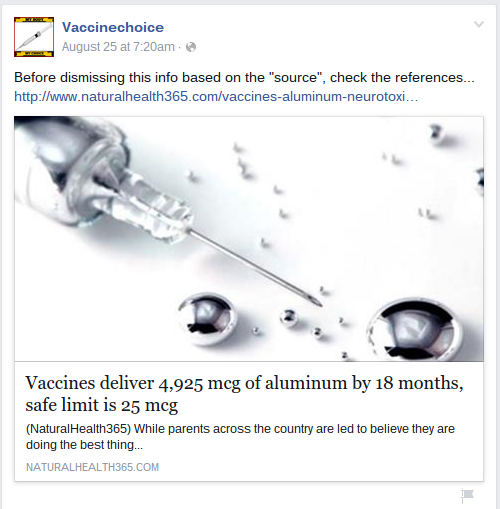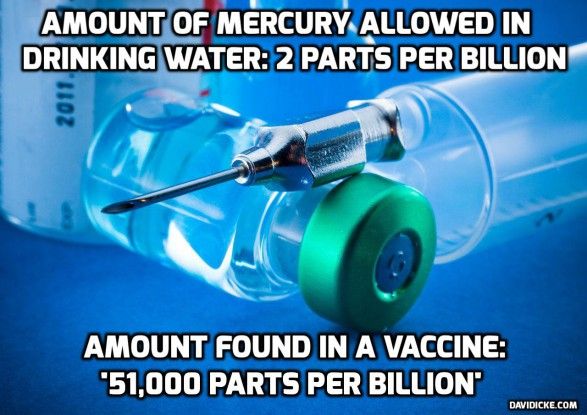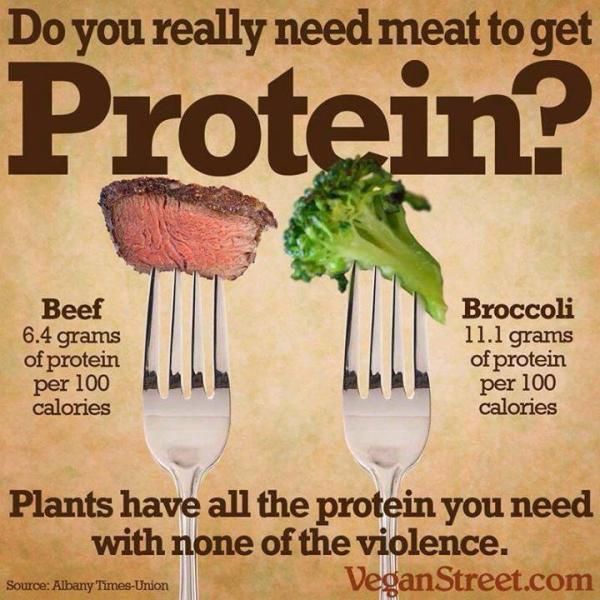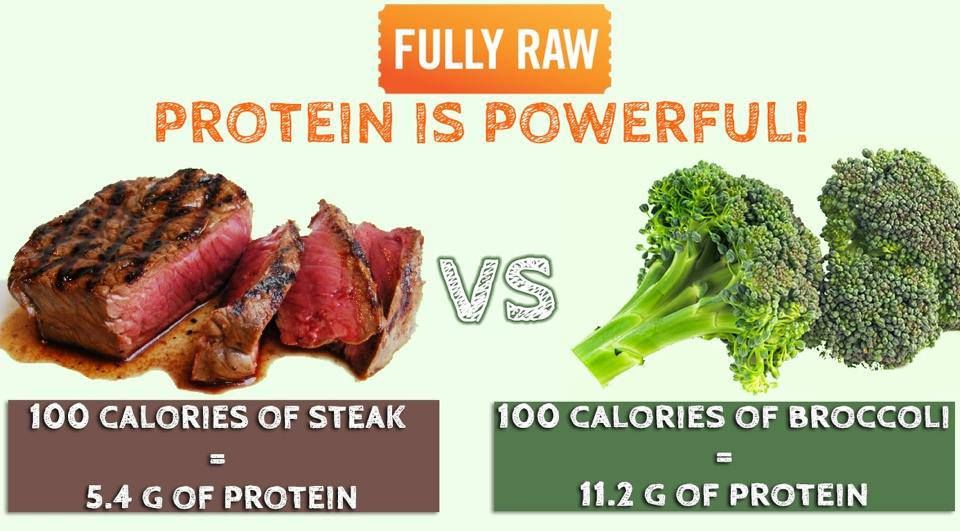Do you ever see a crazy-sounding claim on Facebook, and think to yourself "there's no way that's right?"
When you look closer, they often have some credible-seeming sources for their ideas. Sometimes, those sources are legitimate, and you actually need to change your opinion. Other times, though, those sources are pseudoscience, or are intentionally misinterpreted. These incorrect claims can go on to become persistent myths.
Today, we're going to take a look at three such claims that cropped up on social media, and show how they've artfully manipulated the truth to achieve the result they want.
Do Vaccines Contain Toxic Levels of Aluminum?
Maybe you've seen this one floating around social media lately. Basically, the claim goes that the aluminum content found in vaccines is much higher than the level considered safe for a baby. Sounds scary! Is it true? Not so much.
First off, let's look at their numbers, since they were kind enough to provide specific ones. They claim that vaccines supply 4925 mcg in the first eighteen months, while the level of safe exposure is only 25 mcg. Right off the bat, you should immediately be skeptical of the 25 mcg figure. Mcg stands for 'microgram,' or one-millionth of a gram. That's 1000 times less than a milligram. The symbols look similar, but the amounts are very different.
25 mcg is an incredibly low rate of exposure. For a point of reference, cyanide is considered safe by the CDC until you're consuming at least 50 mcg of it every single day – nevermind over eighteen months. In order for this to be an accurate figure, aluminum would have to be about 1000 times as dangerous as cyanide. As the saying goes, the dose makes the poison. This kind of disregard for dosage is one of the key "tells" of health-related pseudoscience.
So where did they get this figure? The figure comes from an FDA advisory about premature infants and patients with failing kidneys, and sets the safe rate of aluminum exposure for a single injection (not for a year and a half). Right off the bat, if you aren't a preemie or flirting with dialysis, this limit doesn't apply to you at all. Even if it did, it's over the wrong span of time – a single injection is very different than many injections spaced out over a year and a half.
Finally, just to drive the point home, I should be emphasized that this limit applies to intravenous injections (vaccines are intra-muscular). Intravenous injections deliver their contents directly into the blood. Intra-muscular injections are released into the blood much more slowly, which is easier on the kidneys. Even ignoring all the other stuff wrong with it, it's still comparing apples to oranges.
So what's the real safe limit? According to the FDA study on the subject, the safe limit for aluminum exposure through vaccines is about 4.2 mg (4200 mcg) over the first year of life. Even assuming newborns don't get heavier or heartier after their first birthday (they do), the limit for eighteen months would be 6.3 mg, or 6300 mcg - quite a bit more than the 4925 mcg quoted by the post.
To make a long story short, the math on toxic aluminum in vaccines just doesn't add up.
Is the UK More Violent than the US?
This is an old claim, but I've heard it being recirculated again recently, so it's worth taking a minute to refute it. The claim goes, simply, that the UK is more violent than the United States. Generally, this is brought up in opposition to the idea that gun control makes the world safer.
I'm sympathetic to this way of thinking – unfortunately, the math doesn't bear out on this example. The specific claim here is that the UK has 2034 violent crimes per 100,000 people, while the US has only 466. If true, that would make the UK almost 5 times as dangerous. However, the math starts to fall apart pretty much immediately when you start to look into it. The big problem with these figures is that the US and the UK define violent crimes very differently for statistical purposes, which makes this sort of direct comparison impossible.
Specifically, the US counts only murder, non-negligent manslaughter, forcible rape, robbery, and aggravated assault as violent crimes. That's five fairly specific categories of crime. The British Home Office, in contrast, where the other half of the numbers come from, counts violent crime as "all crimes against the person," including all sexual offenses and simple assaults. This also includes things like 'possession of a knife' and "harassment." Less than half of all these crimes produced injuries, and only about a quarter of all of the sex crime categorized was rape. That's a pretty good indication that comparing these figures is misleading.
There's also the point that if we look at homicide specifically, the US rate in 2010 was 4.8, to the UK's 1.2 – the opposite of the trend this meme purports to show. This is not to say that the US is more violent overall – there are other metrics on which the UK is worse – just that these statistics are complex, and you need to be very careful about exactly which metrics you're comparing.
Does Broccoli Contain More Protein Than Steak?
I'm going to be honest, I feel a little bad about this one. Vegans have hard lives, and need all the good news they can get. But sympathy doesn't change anything: this claim is wrong. It's wrong a lot. It's wrong in three totally separate ways.
First off, it's outright factually wrong. The meme claims that beef has 6.4 grams of protein per 100 calories, and broccoli has 11.1 grams per 100 calories. Other versions of the meme use even more extreme values. In reality, according to the USDA, 100 calories of the sirloin steak pictured has 11.08 grams of protein, and 100 calories of broccoli has 8.29. So, right off the bat, no, broccoli does not have more protein than steak.
But, you might be saying, 75% of the protein of steak isn't bad, right? You just have to eat a little more! Unfortunately, this is where we get to the second place this claim is wrong. You see, "per calorie" is a really dumb way to measure nutrition information in this case. What's actually going on here is that broccoli is mostly made of cellulose and water. Since humans don't have rumens (the organs cows use to break down cellulose into a digestible form), the entire thing is pretty much a wash nutritionally. So, it's not so much that broccoli has a lot of protein – it's that it has very few calories.
100 calories of steak is a bit more than one-tenth of one pound. It's really not very much food. In contrast, 100 calories of broccoli (at ~31 calories per cup), is more than three cups of food: about 0.66 pounds of food. To bring the point home, the Dietary Reference Intake guidelines suggest a daily protein intake of 0.36 grams per pound, even for a sedentary adult. A 160 pound adult like myself needs about 58 grams of protein a day to be healthy. Using the 8.29 figure above, that's 700 calories worth of broccoli every day. That's just short of 23 cups of broccoli a day (about five pounds), which is a lot of broccoli - and I'd need even more to maintain an active lifestyle. In contrast, I'd only need about half a pound of steak to achieve the same effect.
But, you might be saying, "That's only about seven cups of broccoli with breakfast, lunch, and dinner. I think I can do that." Unfortunately, you're still out of luck, because we haven't even touched on the third reason this is wrong. This gets into some nutritional technicalities about what protein actually is. "Protein" is sort of a blanket term for a collection of essential amino acids that your body needs to synthesize the proteins that make up your, well, you.
You need all of these amino acids in order to be able to successfully make the proteins you need to grow, put on muscle, and replace dying cells. Steak has a lot of all of them, which makes sense – steak is made of pretty much the same stuff you are. In contrast, broccoli is short on the branch-chained proteinogenic amino acids: leucine, isoleucine, and valine. These account for 35% of the essential amino acids in muscle, and 40% of all required amino acids in mammals. Even the massive portion of broccoli described above would leave you short on all three.
None of this is to say that it isn't possible to be healthy on a vegetarian diet. It is possible, but it requires that you take special care – or use specially formulated nutritional products. Memes like this one spread false information that make people complacent about their health, which is extremely dangerous. People come away from stuff like this thinking that eating a plate of broccoli every day is all it takes to stay healthy, which simply isn't the case.
How to Catch Facebook BS
In many cases, these deceptions aren't difficult to debunk. They're relying on the fact that most of the people seeing them already agree with them - and most of the rest don't care enough to check their math. For the most part, it's not worth spending hours debunking every dumb claim you come across.
However, it is good intellectual practice, from time to time, to pick a fishy-looking claim (especially one you wish were true!) and really pick it apart. Often, these sort of frauds can be detected with only a cursory analysis. Check the units, check the sources, and check that they're actually comparing the same quantities. It's also worth checking Snopes and other fact checking websites to see if anyone's done the legwork for you.
We're considering making this post a weekly column, so please post in the comments if you see any really egregious stinkers, and I'll look into fully debunking it in the future!






